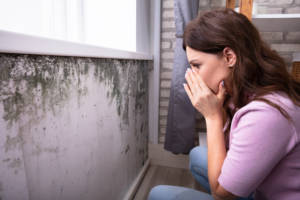Thanks to prolific and often hyperbolic media exposure in recent decades, there are a lot of myths about mold. Some people believe, for example, that all types of mold are extremely dangerous, or that only so-called “toxic black mold” poses a real risk, when in reality, neither of these common perceptions are true.
Understanding the health hazards posed by mold requires an in-depth knowledge of the various categories of mold and mold-related illness-causing agents commonly found in indoor environments: Cosmetic mold, allergenic mold, toxic mold, toxic black mold, pathogenic mold, molds which cause either mycoses/mycosis or mycotoxicoses/mycotoxicosis, and the difference between primary and opportunistic pathogens.
Cosmetic mold very rarely causes either health problems or structural issues; however, it can be very difficult to tell it apart from toxic mold, as it is often dark in appearance. Mold should therefore be presumed to be dangerous and a licenced inspector should be called in to determine whether or not the mold present around your property is cosmetic or not. It is imperative that you not handle any type of mold on your own, especially if you are allergic, asthmatic, have an infant present, are elderly, immune-impaired, etc.
Even if the surface mold in your home is found to be purely cosmetic in nature, it’s still important to check the area for ice dam leaks in walls, hidden plumbing leaks, roof spillage, and foundation issues; these all create damp spaces which are frequently concealed, and which may support any number of the more dangerous mold types outlined below:
Allergenic mold
While allergenic mold was once viewed as being relatively safe if present in small quantities in the past, today, with mold allergy rates rising dramatically (between 2005 and 2008 alone, mold allergy rates increased by 12 percent[1]), the presence of allergenic mold is taken much more seriously. Likewise, some types of allergenic mold can cause illnesses which go beyond mere allergic reactions and venture into the same possibly-fatal territory as poisoning by true toxic mold. Allergenic mold can cause all of the following health problems:
Allergic Rhinitis: This condition, which affects 20-30% of the population, leads to a chronic and sometimes severe runny nose. In addition to being a source of irritation, this condition can lead to poor sleep quality and sinus infections.
Asthma: Asthma, a sometimes-serious respiratory illness, is caused by several varieties of molds commonly found indoors: Cladosporium sp., Alternaria sp., Penicillium sp. and Aspergillus sp. all contain substances which may trigger an asthma attack.
Hypersensitivity pneumonitis, or extrinsic allergic alveolitis: These conditions can be caused by airborne biological particles released from molds, particularly when these particles are spread throughout the air by appliances like water-cooled air conditioning systems. Symptoms include fever, chills, malaise, cough, chest tightness, dyspnea, rash, swelling and headache.[2]
Aspergillosis: This sometimes-fatal illness can develop in people exposed to Aspergillus sp. (particularly individuals who have existing lung disease). The illness begins as an inflammation of the respiratory airways, but may lead to the coughing up of blood, chest pain, fever, difficulty breathing, and occasionally severe, even fatal, bleeding. If not treated promptly, aspergillosis can spread through the blood stream to cause widespread organ damage, leading to kidney failure, liver failure (causing jaundice), breathing problems, and even death. [3]
Pathogenic Mold
Pathogenic mold can cause infections in humans of any age or immune status, so it poses a very real risk even to otherwise healthy individuals. Pathogenic mold causes illnesses as a result of fungus actually growing on or in human.
Pathogenic molds contain either primary pathogens, particularly dangerous even to healthy people, such as of Coccidioides immitis and Histoplasma capsulatum, or opportunistic pathogens, which pose a more significant risk of infection to those with a compromised immune system (e.g. Aspergillus fumigatus and Candida albicans).
Toxic Mold
“Toxic mold” is the name given to those types of mold which either produce or contain chemical poisons capable of seriously affecting human and animal health. Unlike the pathogenic molds discussed above, toxic mold is capable of producing lasting and chronic adverse health effects, rather than merely causing acute issues (such as a short-lived infection which responds to medication and is thereby “cured” permanently unless the individual is exposed to the mold again). Toxic mold may cause serious long term illness to include immune suppression, neuroligal disorders and even cancer.
Toxic mold produces substances known as mycotoxins” with are often housed within the mold’s fungal spores and which may remain present in the fungal material even after the mold is itself is dead or killed chemically. As such, if this material becomes airborne either while the mold is alive or after it has been killed, it can cause severe illness. For this reason, toxic mold should never be handled by a non-professional; no matter how completely you destroy the organic material of the mold itself, the mycotoxins will remain intact, and it’s very likely that you will inhale them during the removal process.
According to Bennett and Kilch (citing an article posted in Clinical Microbiology), “Mycotoxins are secondary metabolites produced by microfungi that are capable of causing disease and death in humans and other animals. Because of their pharmacological activity, some mycotoxins or mycotoxin derivatives have found use as antibiotics, growth promotants, and other kinds of drugs; still others have been implicated as chemical warfare agents… Molds (i.e., microfungi) make mycotoxins; mushrooms and other macroscopic fungi make mushroom poisons. The distinction between a mycotoxin and a mushroom poison is based not only on the size of the producing fungus, but also on human intention. Mycotoxin exposure is almost always accidental.”
Contrary to popular belief, not all types of toxic mold are “black mold”, so you should never assume that a mold which is not dark in color is automatically safe to handle. Likewise, when having mold in your residence or building tested, you should always have all of the types of mold present examined, not just those molds which are dark in color. According to Mold-Help.org, “Most people are not aware that harmful molds come in a variety of colors—they can be white, or orange, or blue, for instance. The color of a mold generally has to do with the spores it produces, and has no bearing on whether it is dangerous or not. There are some white molds that grow on walls and other surfaces that can be just as bad as the harmful black molds.”
That being said, the type of “black mold” (more properly known as Stachybotrys chartarum) which is frequently spoken about in the media is indeed particularly dangerous and is one of the most common forms of toxic mold. Stachybotrys chartarum can cause serious illnesses which range in nature from skin infections, eye infections, lung infections, and neurological damage, to sometimes quite serious long-term conditions, of which cancer is the most notorious—notably, toxic black mold has been proven to cause hepatocellular carcinoma (liver cancer).[4] It is believed that mycotoxins interfere with RNA synthesis and therefore cause DNA damage, which manifests primarily in the liver as the liver is largely responsible for processing those toxins which enter the human body.
Stachybotrys chartarum (often abbreviated to SC) is a greenish-black mold that grows on material with high cellulose content, usually wood, straw, hay, wicker, cardboard, or fiberboard—but only when moisture is present. Other forms of dark mold which grow on these materials in relatively dry conditions (e.g. Cladosporium, Aspergillus, Alternaria, and Drechslera) are often cosmetic or allergenic in nature; SC needs a good deal of dampness to flourish. According to Mold-Help.org, the toxic effects of Stachybotrys chartarum were “First reported in the 1920s in Russia when horses and cattle that had eaten moldy hay began dying,” and during the “‘Yellow Rain’ attacks in Southeast Asia in the 1970s [which] were associated with aerosolized trichothecenes, the type of mycotoxin produced by this highly toxic type of mold.”
While it’s not conclusively known why some forms of mold contain such virulent toxins, it is believed that some varieties of mold developed mycotoxins as a way of protecting their natural environment, preventing other organisms from invading it.
Regardless of the purpose for which they were originally intended, it is certain that mycotoxins are not only extremely potent, they can affect nearly every organ system in your body, including the central nervous system (where they have effects similar to those of a neurotoxin), causing cognitive and behavioral changes, ataxia, and convulsions. It has been shown that approximately 70 percent of the people with confirmed exposure to toxigenic molds exhibit symptoms consistent with significant neurotoxicity.[5]
According to mold expert Dr. Jack Thrasher, the lasting neurotoxic effects of mycotoxins are partly due to the way these toxins can cross into the human brain owing to the fact that our olfactory neurons (to which mycotoxins bind when inhaled) are in direct communication the brain. Likewise, mycotoxins have also been found to enter the brain via the optic muscles and optic nerves, meaning that even if one is protecting one’s airways while in the presence of toxic mold, brain penetration through eye exposure is a very real possibility.[6]
Toxic molds have been found to contain more than 200 mycotoxins, most of which are lipid-soluble and readily absorbed by the intestinal lining, airways, and skin, causing profound effects even when present only in very small quantities. The most significant mycotoxins that are known to frequently affect humans (and other animals) are aflatoxin, citrinin, ergot akaloids, fumonisins, ochratoxin A, patulin, trichothecenes, and zearalenone. These toxins may enter the body if a person consumes contaminated food or if they touch or inhale spores while attempting to clean moldy areas.
There is, however, a lot of variability in where these toxins may develop. Even where common strains of toxic mold are present, dangerous mycotoxins do not always occur; according to Mold-Help.org:
“Laboratory studies indicate that molds such as Stachybotrys that have the ability to produce toxins do not always do so. Whether a mold produces a toxin while growing in a building may depend on what the mold is growing on, conditions such as temperature, food, pH, humidity or other unknown factors. When mycotoxins are present, they occur on spores and the small mold fragments that may be released into the air.”
As such, once again, only the oversight of a professional—who can do tests underneath a microscope—can determine whether or not you truly have a toxic mold within your building or residence.
If you do have a toxic mold problem, it’s essential to understand that the mycotoxins which sometimes thrive within molds like SC can survive temperatures up to 500 degrees F, in addition to being able to withstand caustic agents like bleach and acid. According to Dr. Michael Gray, spores from molds removed from two million year-old sedimentary rocks have demonstrated the ability to grow when placed in favorable conditions.[7] In short, destroying these toxins is no casual matter, and the task must be left to expert hands.
[1] Allergies Increase, Scientists Scratch Their Heads, http://www.livescience.com/35721-allergy-increase-ragweed-mold-global-warming.html
[2] https://en.wikipedia.org/wiki/Hypersensitivity_pneumonitis#Symptoms
[3] https://en.wikipedia.org/wiki/Aspergillosis#Symptoms
[4] Mold: The Common Toxin That Can Be FAR More Damaging Than Pesticides and Heavy Metals, http://articles.mercola.com/sites/articles/archive/2011/09/03/molds-making-you-ill.aspx
[5] http://www.urthtech.com/blog/molds-mycotoxins-and-human-health
[6] http://www.ncbi.nlm.nih.gov/pubmed/16835065
[7] Mold: The Common Toxin That Can Be FAR More Damaging Than Pesticides and Heavy Metals, http://articles.mercola.com/sites/articles/archive/2011/09/03/molds-making-you-ill.aspx






